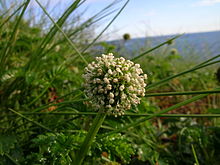| Red bidibid | |
|---|---|

| |
| Scientific classification | |
| Kingdom: | Plantae |
| Clade: | Tracheophytes |
| Clade: | Angiosperms |
| Clade: | Eudicots |
| Clade: | Rosids |
| Order: | Rosales |
| Family: | Rosaceae |
| Genus: | Acaena |
| Species: | A. novae-zelandiae |
| Binomial name | |
| Acaena novae-zelandiae Kirk | |
Acaena novae-zelandiae, commonly known as red bidibid, bidgee-widgee, buzzy and piri-piri bur, is a small herbaceous, prostrate perennial, native to New Zealand, Australia and New Guinea, of the family Rosaceae.
Description
Acaena novae-zelandiae is a small herbaceous perennial. It is stoloniferous with prostrate stems of 1.5 – 2 mm diameter. Damage to stolons encourages new shoots to be produced.

It has imparipinnate leaves, with 9–15 toothed, oblong leaflets, which are approximately 2 –11 cm long. The adaxial surface of the leaves is dark green and shiny, and the abaxial surface is hairy and glaucous green in colouration. The rachis of the leaves is often red.
The scape is 10 – 15 cm long and bears a globular, terminal inflorescence, of 20 – 25 mm diameter, with 70 – 100 flowers. The flowers lack petals and can range in colour from green to white or purple. The flowers are wind pollinated.

Each flower produces one achene, bearing four approximately 10 mm long spines, tipped with barbs, which aid dispersal by attaching to wool, feathers and various clothing materials. When the fruit are ripe, these spines are red in colouration, later becoming brown.
Taxonomy and naming
Acaena novae-zelandiae was first formally described in 1871 by Thomas Kirk who published the description in Transactions and Proceedings of the New Zealand Institute. The genus name (Acaena) is derived from the Ancient Greek word akaina meaning "thorn" or "spine", referring to the spiny calyx of many species of Acaena. The specific epithet (novae-zelandiae) refers to New Zealand.
Distribution and habitat
Red bidibid is native to New Zealand, Australia and New Guinea. It has also become naturalised in California, Great Britain and Ireland. It is regarded as invasive in Great Britain where it has established itself in places such as dune habitats on Lindisfarne.
It occurs within a wide range of habitats, including woodlands, shrublands and grasslands, from coastal areas to alpine areas. It grows in freely draining soils such as silty and sandy loams, typically on sites which receive a high amount of sunlight.
It also establishes readily on disturbed sites such as roadsides.
Uses
Acaena novae-zelandiae may be used for ground cover in gardens or as a lawn substitute. This plant can be prevented from spreading by limiting disturbance to stolons, thus reducing vegetative propagation, and by mowing flowers before the burrs form.
It has also been suggested that dried "tiny tips" of young succulent leaves may be brewed as tea.
References
- ^ "Acaena novae-zelandiae". New Zealand Plant Conservation Network. Retrieved 12 August 2018.
- ^ Australia, Victorian Resources Online, Agriculture Victoria. "Bidgee-widgee". vro.agriculture.vic.gov.au. Retrieved 12 March 2018.
{{cite web}}: CS1 maint: multiple names: authors list (link) - "View By Common Name | Tamar Valley Weed Strategy". weeds.asn.au. Retrieved 12 March 2018.
- "Pirri-pirri-bur". IWSL. Retrieved 12 March 2018.
- ^ Webb, C; Sykes, W; Garnock-Jones, P; Given, D (1988). Flora of New Zealand : Volume IV, Naturalised Pteridophytes, Gymnosperms, Dicotyledons. Christchurch, NZ: Botany Division, D.S.I.R. p. 1062.
- ^ Agriculture, California Department of Food and. "CDFA > PLANT > INTEGRATED PEST CONTROL > Encycloweedia > Noxious Weed Photographic Gallery > Acaena genus". cdfa.ca.gov. Archived from the original on 19 December 2017. Retrieved 12 March 2018.
- ^ Gynn, E; Richards, A (1985). "Acaena Novae-Zelandiae T. Kirk". Journal of Ecology. 73 (3): 1055–1063. doi:10.2307/2260167. JSTOR 2260167.
- "Bidgee-widgee". Grains Research and Development Corporation. Archived from the original on 30 June 2018. Retrieved 12 March 2018.
- ^ Mount, A; Pickering, C (2009). "Testing the capacity of clothing to act as a vector for non-native seed in protected areas". Journal of Environmental Management. 91 (1): 168–179. doi:10.1016/j.jenvman.2009.08.002. hdl:10072/29656. PMID 19717222.
- "Acaena novae-zelandiae". APNI. Retrieved 12 August 2018.
- Kirk, Thomas (1871). "Descriptions of new plants". Transactions and Proceedings of the New Zealand Institute. 3: 177–178. Retrieved 12 August 2018.
- Brown, Roland Wilbur (1956). The Composition of Scientific Words. Washington, D.C.: Smithsonian Institution Press. p. 796.
- "Pirri-pirri-bur". Plant Life. Retrieved 12 August 2018.
- "Pirri-pirri burr (Acaena novae-zelandiae)". GB non-native secretariat. Retrieved 12 August 2018.
- ^ "Bidgee-widgee – Victorian Native Seed". Victorian Native Seed. Retrieved 12 March 2018.
- ^ "Plants for the water friendly garden" (PDF). City of Clarence. Archived from the original (PDF) on 12 March 2018. Retrieved 12 March 2018.
- "Plants of Tasmania Nursery & Gardens". potn.com.au. Retrieved 12 March 2018.
- Hopkins, Kat; Alexander, Mark. "Edible Native Plants of Tasmania" (PDF).
| Taxon identifiers | |
|---|---|
| Acaena novae-zelandiae |
|